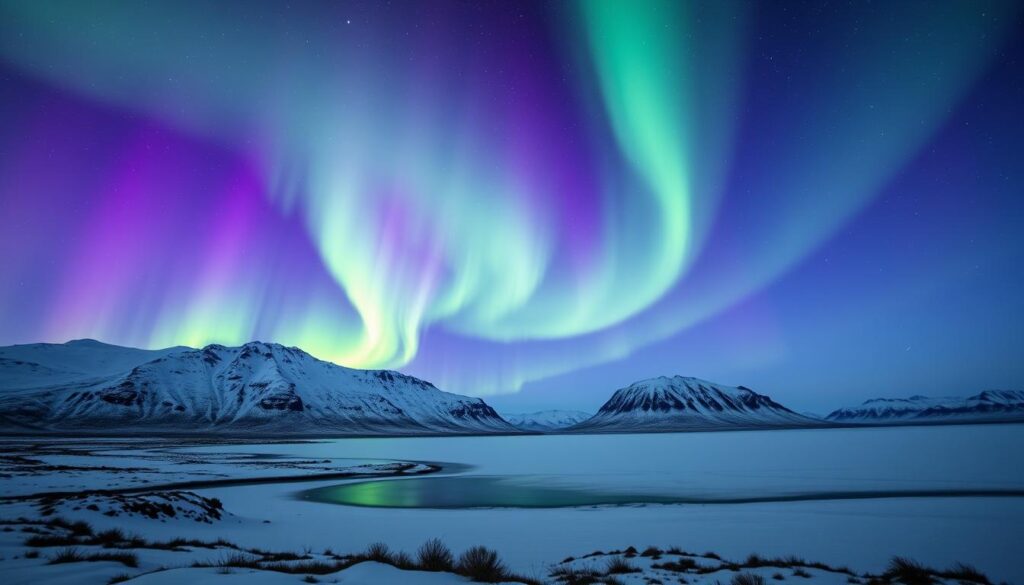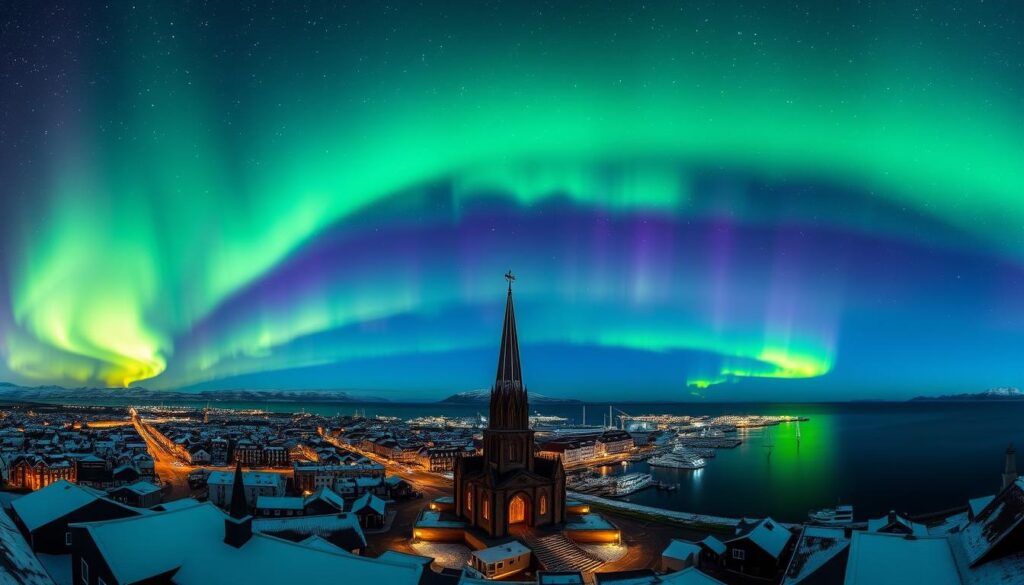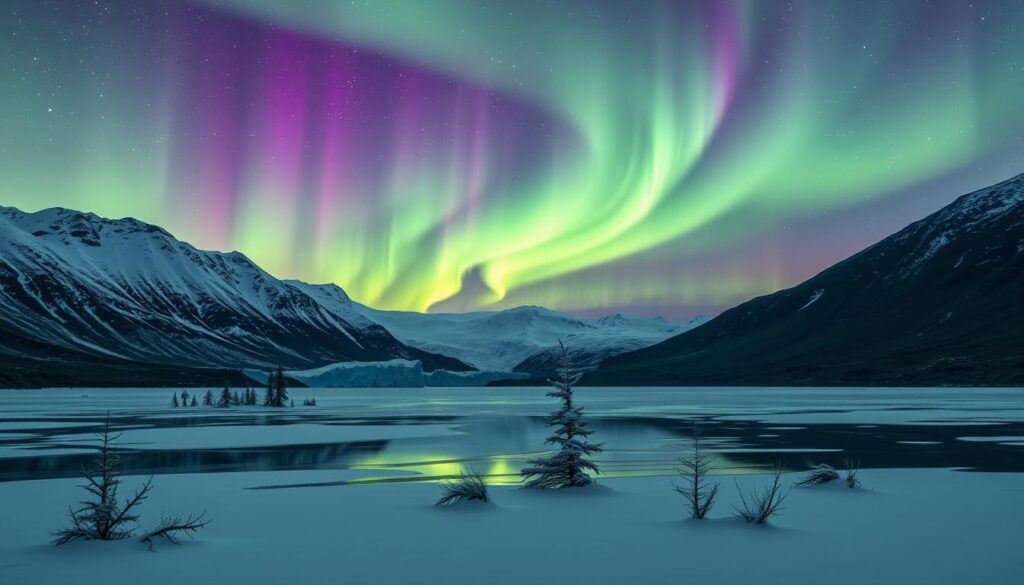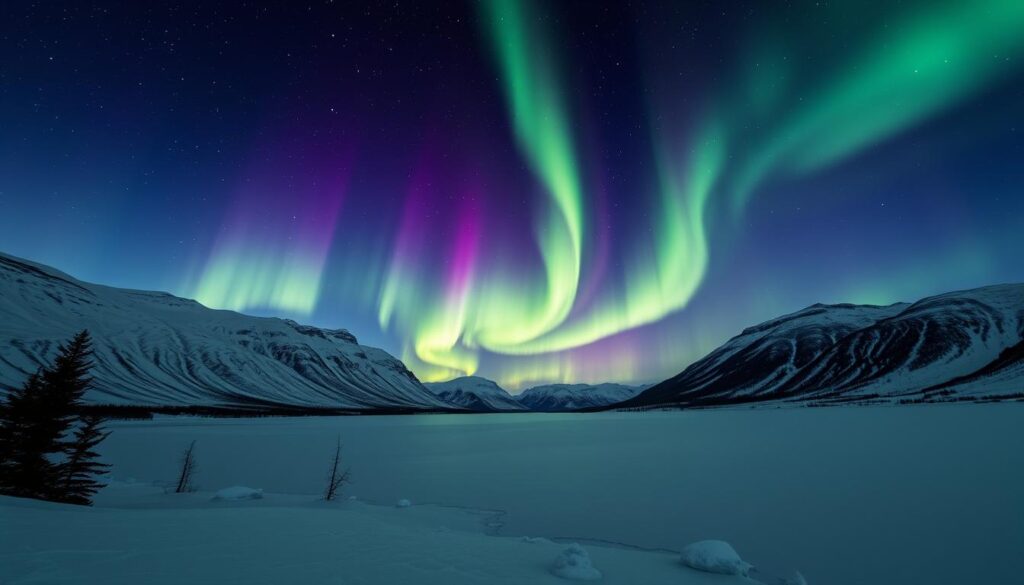As the cold Arctic air wraps around me, I feel a mix of wonder and excitement. The sky is about to show off a breathtaking sight – the aurora borealis dancing across the Icelandic sky. From September to April, Iceland turns into a magical place. It’s the perfect time to see the Northern Lights in all their glory.
Key Takeaways
- Iceland’s untouched nature and long nights make it perfect for seeing the aurora borealis.
- Great spots for viewing include areas around Reykjavik, the Snæfellsnes Peninsula, and places like Akureyri and Lake Mývatn.
- Guests can explore icy landscapes, try snowmobiling and glacier hiking, and soak in geothermal pools. All while watching the Northern Lights.
- The aurora borealis is most visible in Iceland’s winter, from late-September to mid-April.
- Iceland is a unique mix of natural beauty and winter fun. It’s a top spot for Northern Lights fans.
Understanding the Aurora Borealis: Nature’s Light Show
The Iceland night sky wonders come alive with the breathtaking display of the Aurora Borealis, also known as the Northern Lights. This natural phenomenon is the result of solar particles entering the Earth’s magnetic field. They ionize in the atmosphere, creating vibrant colors that dance across the Arctic sky.
The Science Behind the Northern Lights
Iceland’s latitude of 64 degrees north makes it an ideal location to witness the Iceland aurora photography. The Northern Lights are typically visible near the Earth’s magnetic poles. The long hours of darkness during the winter months in Iceland create the perfect conditions for this natural spectacle.
Ancient Nordic Folklore and Beliefs
While ancient Nordic folklore regarding the Aurora Borealis is sparse, other cultures around the world have rich myths and beliefs surrounding this phenomenon. From the Inuit’s belief that the lights are the souls of the dead to the Sami’s idea that they are the reflections of the sun on the water, the Aurora Borealis has long been a source of fascination and wonder for people across the globe.
Colors and Patterns in the Arctic Sky
The Northern Lights typically appear in shades of green, but they can also display hues of purple, red, pink, orange, and blue. These colors create mesmerizing patterns and shapes that dance across the Arctic sky. The colors and patterns are determined by the type of particles involved and the altitude at which they interact with the Earth’s atmosphere.
Witnessing the Iceland aurora photography is a truly awe-inspiring experience. Iceland’s unique position near the magnetic poles makes it an ideal destination for those seeking to capture the magic of the Northern Lights.
“The Northern Lights are nature’s own light show, a mesmerizing dance of color and energy that captivates all who witness it.”
Best Time to Experience Northern Lights in Iceland
The best time to see the Northern Lights in Iceland is from September to April. The winter months offer the best views. December and January have up to 20 hours of darkness, perfect for watching the aurora borealis.
The Icelandic Met Office gives a Northern Lights forecast, from one to nine. You need clear skies and little light pollution for the best view. A week-long trip boosts your chances of seeing the lights several times.
| Month | Northern Lights Visibility | Daylight Hours |
|---|---|---|
| September – April | Best | 4-5 hours |
| May – August | Lowest | 20 hours |
For the best time to see northern lights in Iceland, look for clear, dark skies. Avoid areas with light pollution. Winter nights are long, making it easier to see the Aurora Borealis. Iceland’s remote areas and low population density make it ideal for viewing.
“The Northern Lights are a mesmerizing natural phenomenon that captivate visitors from around the world. Planning your trip to Iceland during the winter months is the best way to increase your chances of seeing this breathtaking display.”
Prime Viewing Locations Across Iceland
Iceland offers many places to see the northern lights. You can find spots near Reykjavik or in North Iceland. Each place has its own beauty, making your winter trip unforgettable.
Remote Spots Near Reykjavik
Reykjavik might not be the best for seeing the northern lights because of city lights. But, there are quiet spots outside the city. The Seltjarnarnes peninsula and the Grotta lighthouse area are great for a peaceful view.
South Coast Viewing Points
The south coast of Iceland is famous for northern lights viewing. Jökulsárlón glacier lagoon is stunning with its icebergs and water. Skógafoss waterfall and Reynisfjara’s black sand beaches are also amazing.
North Iceland’s Aurora Hotspots
North Iceland is the best place for seeing the northern lights. Places like Akureyri, Húsavík, and Tröllaskagi peninsula have clear skies. Don’t miss Ásbyrgi canyon and Kirkjufell mountain on the Snæfellsnes peninsula.
“Iceland’s northern lights are a natural wonder that truly captivates the senses. From the remote and serene locations near Reykjavik to the breathtaking vistas of the south coast and the aurora hotspots of North Iceland, each viewing spot offers a unique and unforgettable experience.” – Aurora Borealis enthusiast
Weather Conditions and Optimal Viewing Circumstances
To see the Iceland night sky wonders of the Northern Lights, you need the right weather. You need clear skies and little light pollution. The Icelandic aurora forecast helps plan your Northern Lights trips by showing cloud cover and activity.
In Iceland’s winter, the nights are long and dark. This makes it easier to see the Iceland night sky wonders. December is very cold and dark, with the sun out for just a few hours. But, the aurora is unpredictable, so you must be patient.
| Weather Condition | Optimal Viewing |
|---|---|
| Cloud Cover | Clear skies for unobstructed views |
| Light Pollution | Minimal light pollution for enhanced visibility |
| Darkness | Extended periods of darkness during winter months |
| Aurora Forecast | Monitoring cloud cover and aurora activity |
While you can’t predict the Iceland night sky wonders exactly, knowing the weather helps. With patience and luck, you can see the Northern Lights in Iceland.
“The Northern Lights in Iceland are a true natural wonder, a spectacle that captivates the senses and leaves a lasting impression on all who witness them.”
Iceland’s Northern Lights: A Winter Wonderland
See the Icelandic winter landscape turn into a winter wonderland when you visit. As the days get shorter and it gets colder, the country’s beauty becomes magical. It’s an experience you won’t forget.
Transforming Landscapes
The snow-covered mountains, frozen waterfalls, and sparkling glaciers are breathtaking. Go on a snowmobile across the Langjökull glacier or check out the ice caves. The light and ice there create a stunning show.
Seasonal Activities and Attractions
Winter in Iceland is packed with fun activities and sights. Try a glacier hike on Sólheimajökull or Vatnajökull or get excited about snowshoeing and ice climbing on the Golden Circle. Relax in the Blue Lagoon, Secret Lagoon, and Mývatn Nature Baths. Soak in the warm waters while enjoying the winter scenery.
Winter Photography Tips
Here are key tips for capturing the Icelandic Icelandic winter landscape:
- Use a sturdy tripod to stabilize your camera during low-light conditions.
- Shoot in RAW format to allow for more flexibility in post-processing.
- Adjust your camera settings to accommodate the low-light conditions, such as increasing the ISO and using longer exposure times.
“The winter in Iceland transforms the country into a magical, snow-covered wonderland, offering a truly unforgettable experience for visitors.”
Northern Lights Tours and Guided Experiences
Seeing the northern lights in Iceland is best with guided tours. These tours help you see the aurora borealis. They make sure you have the best chance to see this amazing sight.
Iceland northern lights tours start in Reykjavik. They take you to places far from the city. Super jeep tours go off-road to find secret spots. Bus tours are cheaper and still great for seeing the lights.
Try a northern lights travel package that includes a boat tour. These two-hour cruises offer a wide view of the lights in the sky.
Guided tours come with extra perks. You get:
- Warm, weatherproof clothing
- Hot drinks to stay warm
- Help with taking photos of the lights
Local guides make sure you see the northern lights. They handle all the details. This way, you can enjoy your trip to Iceland without worry.
| Tour Feature | Inclusion |
|---|---|
| Guided coach tour | From day 2 to day 5 |
| Expert professional English-speaking local guide | From day 2 to day 5 |
| Free Wi-Fi on board the motor coach | Yes |
| Accommodation | 2 nights in a standard room with facilities in Reykjavik, 3 nights in a standard room with facilities in the countryside |
| Icelandic breakfast | Except arrival day |
| Local-cuisine dinners | 3 two-course (main course and dessert) with coffee/tea (day 2, 3, 4) |
| Entrance fees | Aurora Reykjavik Northern Lights Centre (day 2), LAVA Centre and volcano film (day 3) |
| Activities | Visit to outdoor geothermal bakery, horse farm, Blue Lagoon, northern lights guided hunt on foot |
| Customer support | 24-hour Iceland travel emergency line assistance |
| Northern lights “wake-up call” | Available at most countryside hotels (days 2-4) |
The cost for a Iceland northern lights tour is $1,495 per person. This price is for a double or twin room. There are many dates to choose from during the aurora season. These tours make seeing the northern lights easy and fun.
Combining Aurora Viewing with Geothermal Adventures
For the ultimate Icelandic experience, mix your [Iceland aurora photography] with visits to geothermal hot spots. The Blue Lagoon offers a surreal setting for the Aurora Borealis. Other spots like the Secret Lagoon and Reykjadalur Baths provide cozy warmth and a chance to see the Northern Lights.
Blue Lagoon Under the Lights
The Blue Lagoon, just 40 minutes from Keflavík airport, is a top spot for [Iceland aurora photography] fans. Spend up to 5 hours in the warm, mineral-rich waters. Keep an eye on the sky for the Aurora Borealis.
Secret Lagoons and Hidden Gems
Explore beyond the Blue Lagoon to find Iceland’s hidden geothermal spots. The Secret Lagoon and Reykjadalur Baths offer unique [Iceland aurora photography] views. The Sky Lagoon, further north, offers luxury and a chance to see the Northern Lights.
In North Iceland, the Mývatn Nature Baths are perfect for [Iceland aurora photography] fans. Surrounded by volcanoes, these pools let you soak in warmth while watching the Aurora Borealis.
“The combination of soaking in the warm, mineral-rich waters while watching the Northern Lights was an unforgettable experience. It truly felt like a magical, otherworldly moment.”
Whether you pick the famous Blue Lagoon or explore Iceland’s hidden geothermal spots, [Iceland aurora photography] viewing with a soak is a must. It’s a unique experience in the Land of Fire and Ice.
Photography Tips for Capturing the Aurora
To capture the Northern Lights in Iceland, you need the right camera techniques. Use a sturdy tripod to keep your shots stable. Choose a wide-angle lens to show more of the night sky wonders.
Set your camera to manual mode. Increase the ISO to 1600-3200 and use a wide aperture (f/2.8-f/4) to let in more light.
Try shutter speeds between 5-30 seconds for the best detail and motion. Shooting in RAW gives you more flexibility for editing. For smartphone users, there are apps that can improve your aurora photos.
Don’t forget extra batteries because the cold can drain them fast. With the right equipment and skills, you’ll capture the Iceland aurora and make beautiful photos to keep forever.







